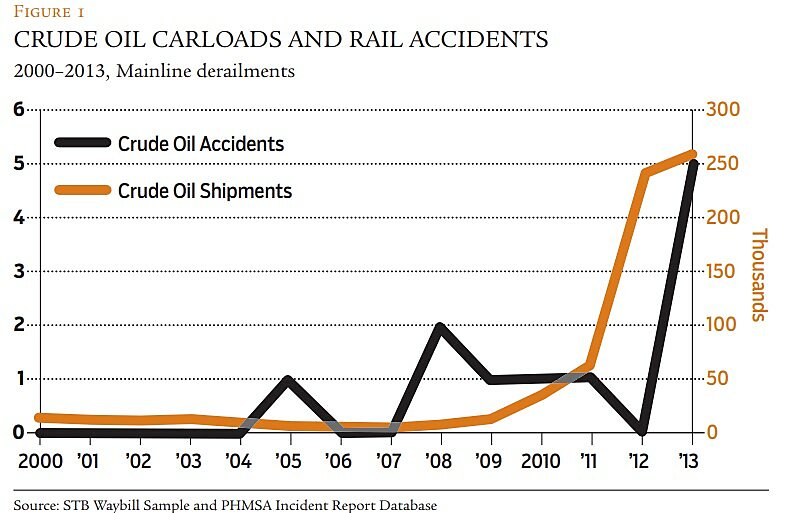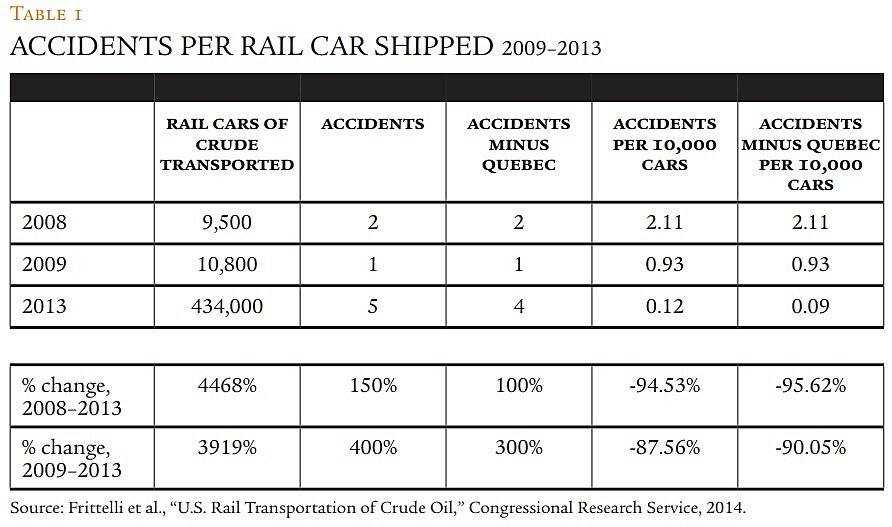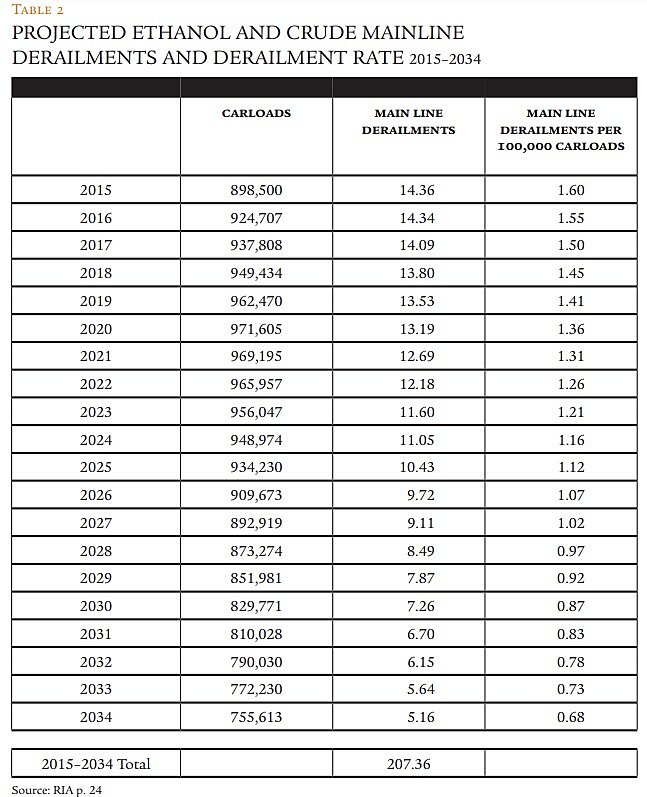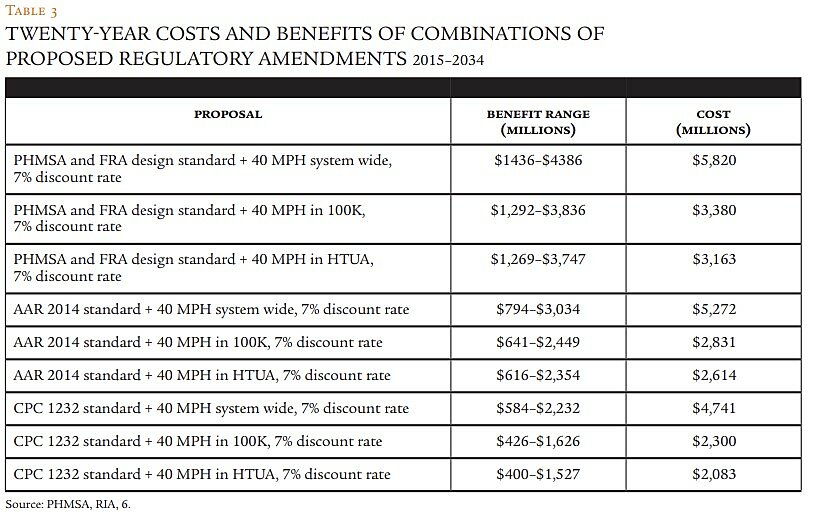The economic justification for rail car regulation depends on the one high-consequence accident (with more than $1 billion in damages) that occurred in Quebec in 2013. No accident of such consequence has ever occurred in the United States. This one foreign event leads the PHMSA to estimate that in the next 20 years the United States will experience as many as 10 high-consequence events, including one possible “super” event that causes damages of more than $6 billion.
Table 3 reproduces the cost and benefit calculations of the PHMSA regarding the proposed rules. In nearly all the cases, the costs exceed the benefits (costs avoided by spill prevention). Only the second and third proposals show possible positive net benefits, and that is only because the benefit calculation assumes that 10 high-consequence events (one of them a super event) will occur in the next 20 years. A one-time event in a foreign country has been transformed into a systemic event in the United States.
The PHMSA calculation of property and environmental damages is also questionable. The PHMSA uses $300 per gallon spilled for low-consequence events. However, that number is derived from the high-consequence Quebec accident and inflates the benefit calculation for low-consequence events.
WHAT IS THE MARKET FAILURE?
The RIA states that the PHMSA must act because of market failure as a result of shippers and railroads not insuring “against full liability of the consequences involving hazardous materials. As a result, these events impose externalities.” Most Class I railroads carry a self-insured retention of between $25 million and $50 million and maintain between $750 million and $1 billion in coverage. The PHMSA asserts that even if rail carriers have large amounts of insurance, the coverage will be less than the cost of a super event.
How much insurance should a firm purchase? The 40 U.S. mainline derailments since 2006 have resulted in total damages of about $47 million ($14.13 per gallon released), or $1.18 million per derailment. Even if we use the PHMSA’s preferred damage estimate of $300 per gallon released, the damages would be only $25 million per derailment. Railroads appear to purchase sufficient insurance and are more than able to cover their expected damages from a typical low-consequence event. And at the upper end, their insurance almost covers the damages of another Quebec accident. They do not have enough insurance, however, to cover a $6 billion super event. Is that a problem?
The optimal amount of insurance depends on the governing tort regime. Under a strict liability regime, the defendant is liable for harm to the plaintiff regardless of whether the defendant took reasonable precautions. Under a negligence regime, in contrast, the defendant is liable for the plaintiff’s harm only if the plaintiff can establish that the defendant was negligent. Under strict liability, risk-averse firms should purchase insurance that covers the costs of all accidents. Under negligence, both firms and consumers should purchase coverage.
The PHMSA could certainly argue on firm ground that a market failure exists when injurers “do not have assets sufficient to pay fully for the losses they cause”—that is, when potential damages exceed net worth. The PHMSA should examine the current liability system and determine if railroads and crude oil shippers have sufficient assets or insurance to pay for potential damages. If not, changes in tort or insurance requirements might be more cost-effective than the proposed rules from the PHMSA.
Standard law and economics analysis holds that strict liability is the appropriate tort regime for hazardous materials because defendants (usually railroads) are the least-cost avoiders—that is, they can avoid accidents at the lowest cost. Under a strict liability tort regime, railroads would seek to indemnify themselves with more insurance coverage. In turn, insurance companies would require railroads to take additional cost-effective precautions in return for lower premiums. Thus, market forces make insurance companies the regulators rather than the PHMSA itself.
The stated goal of the PHMSA proposed rules is “reducing the risks posed by [High Hazard Flammable Trains], … taking action to prevent accidents from occurring, and … mitigat[ing] the consequences when accidents do occur.” One obvious solution would be to transport crude oil through pipelines, although some commentators argue that pipelines are not safer. But pipelines as well as barges, tanker ships, and tanker trucks should all be analyzed. The U.S. State Department’s January 2014 Final Supplemental Environmental Impact Statement for the proposed Keystone XL pipeline estimates that crude oil transported via the pipeline would spill 518 barrels a year, while the same amount transported by rail would spill 1,335 barrels per year at minimum. (However, a brochure from the Association of American Railroads states that the spill rate for crude oil transported by rail is 0.38 gallons per million barrel miles moved as opposed to 0.88 gallons per million barrel miles moved by pipeline.) And transporting oil by pipeline is safer in terms of injuries. If regulations are inhibiting the construction of pipelines in the Bakken region, then eliminating those regulations—rather than adding tank car regulation—should be analyzed.




